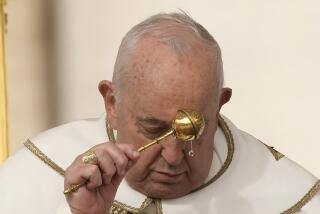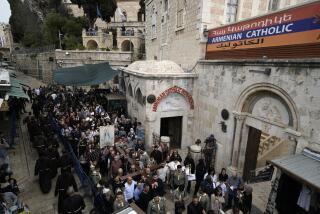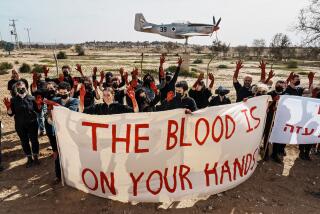Pope Francis calls for end to Israeli-Palestinian stalemate

Pope Francis called the Israeli-Palestinian stalemate “unacceptable” as he landed Sunday in the West Bank town of Bethlehem in a symbolic nod to Palestinian aspirations for their own state.
Jubilant, flag-waving Palestinians greeted Francis on the second day of his Mideast pilgrimage, which featured a Mass in Manger Square on a stage next to the Church of the Nativity, built over Jesus’ traditional birth grotto. Giant Palestinian flags in red, white, green and black hanging alongside the Vatican’s yellow-and-white flags decorated the square.
Previous popes always came to the West Bank after first arriving in Tel Aviv, Israel. Francis, however, landed at a Bethlehem helipad from Jordan aboard a Jordanian helicopter and immediately headed into an official welcoming ceremony and meeting with Palestinian President Mahmoud Abbas.
Standing alongside Abbas, Francis declared: “The time has come to put an end to this situation which has become increasingly unacceptable.” He said both sides needed to make sacrifices to create two states, with internationally recognized borders, based on mutual security and rights for everyone.
“The time has come for everyone to find the courage to be generous and creative in the service of the common good,” he said.
In his remarks, Abbas voiced his concerns about the recent breakdown in U.S.-backed peace efforts and lamented the difficult conditions facing the Palestinians. He also expressed hope for peace.
“Your visit is loaded with symbolic meaning as a defender of the poor and the marginalized,” he said.
Abbas listed a series of complaints against Israel, including continued settlement construction, the plight of thousands of Palestinian prisoners, Israel’s control of east Jerusalem, the Palestinians’ would-be capital and Israel’s construction of the “ugly wall” that encircles Bethlehem.
“We welcome any initiative from you to make peace a reality in the Holy Land,” Abbas said. “I am addressing our neighbors — the Israelis. We are looking for the same thing that you are looking for, which is safety, security and stability.”
Bethlehem is surrounded on three sides by Israel’s separation barrier. Israel says the barrier is a necessary security measure. But the Palestinians say it has engulfed land across the West Bank and stifled life in Bethlehem. After meeting Abbas, Francis stepped out of his open-air vehicle to inspect the massive concrete structure.
Francis spent a few minutes at the wall, surrounded by Palestinians waving Vatican flags and taking pictures with their cellphones, then boarded his open-topped car the rest of the ride to Manger Square.
Security was lax by papal standards, even for a pope who has shunned the armored popemobile that his predecessors used on foreign trips.
When Francis went to Brazil last year, a half-dozen or more bodyguards jogged alongside his open-topped car any time he went out. With the crowds smaller in Bethlehem, only two bodyguards stood on the back of Francis’ vehicle keeping watch as Palestinian police kept the crowd at bay. Francis waved and warmly smiled as his car made its way through the crowd in Manger Square.
Palestinian officials have hailed Francis’ decision to arrive first in Bethlehem, rather than Tel Aviv, and to refer to the “state of Palestine.” In its official program, the Vatican referred to Abbas as the president of the “state of Palestine,” and his Bethlehem office as the “presidential palace.”
“The fact that he is coming straight from Jordan to Bethlehem, without going through Israel,” is a tacit recognition of a Palestinian state, said Hanan Ashrawi, a Palestinian Christian who is a senior official in the Palestine Liberation Organization.
In November 2012, the United Nations General Assembly overwhelmingly recognized a “state of Palestine” in the West Bank, Gaza and east Jerusalem — lands Israel captured in the 1967 war — as a non-member observer. The recognition still has little meaning on the ground, with Israel remaining in full control of east Jerusalem, which it annexed in 1967, and the West Bank.
However, it has enabled the Palestinians to start seeking membership in U.N. agencies and accede to international conventions in a further upgrade of their status. Israel objects to the Palestinian campaign, saying it is an attempt to bypass negotiations.
Francis is expected to press the Vatican’s call for a two-state solution to the Israeli-Palestinian conflict upon his arrival in Israel. He is also expected to give a word of encouragement to Palestinian Christians, whose numbers have been dwindling as the conflict drags on.
Currently, Christians are roughly 2 percent of the population of the Holy Land, down from about 10 percent at the time of Israel’s establishment. In Bethlehem, they are less than one third of the population, down from 75 percent a few decades ago.
Early Sunday, police arrested 26 Israelis for throwing stones at police officers and causing disturbances at a Jerusalem holy site where the pope will celebrate Mass at the end of his trip, Israeli police spokesman Mickey Rosenfeld said.
Rosenfeld said 150 religious Jews demonstrated at the holy site to protest rumors that Israel will transfer control of the site to the Vatican. According to Catholic tradition, the site marks the Last Supper of Jesus. But devout Jews believe the biblical King David is buried there, and they protest Christian prayer at the site. Israeli officials say there are no plans to turn the site over to the Vatican, but that they may reach a deal to allow more Christian prayer.
Francis’ day calls for him to celebrate the Mass in Manger Square, where a large poster with a Nativity scene and the pontiff’s three predecessors served as a backdrop to the altar. Many in the crowd also wore black-and-white checkered scarves around their heads or necks, a symbol of the Palestinian cause, and held clusters of balloons in the colors of the two flags.
After Mass, he was to lunch with Palestinian families and visit a Palestinian refugee camp before arriving at Tel Aviv’s Ben Gurion airport for a welcome ceremony.
His final event of the day is to be a prayer service with the spiritual leader of the world’s Orthodox Christians at the Church of the Holy Sepulcher in Jerusalem, where Christians believe Jesus was crucified, buried and resurrected. Francis has said the encounter marking the 50th anniversary of a landmark meeting between Pope Paul VI and Ecumenical Patriarch Athenagoras, which ended 900 years of Catholic-Orthodox estrangement, was the primary reason for his three-day pilgrimage.
More to Read
Start your day right
Sign up for Essential California for news, features and recommendations from the L.A. Times and beyond in your inbox six days a week.
You may occasionally receive promotional content from the Los Angeles Times.






